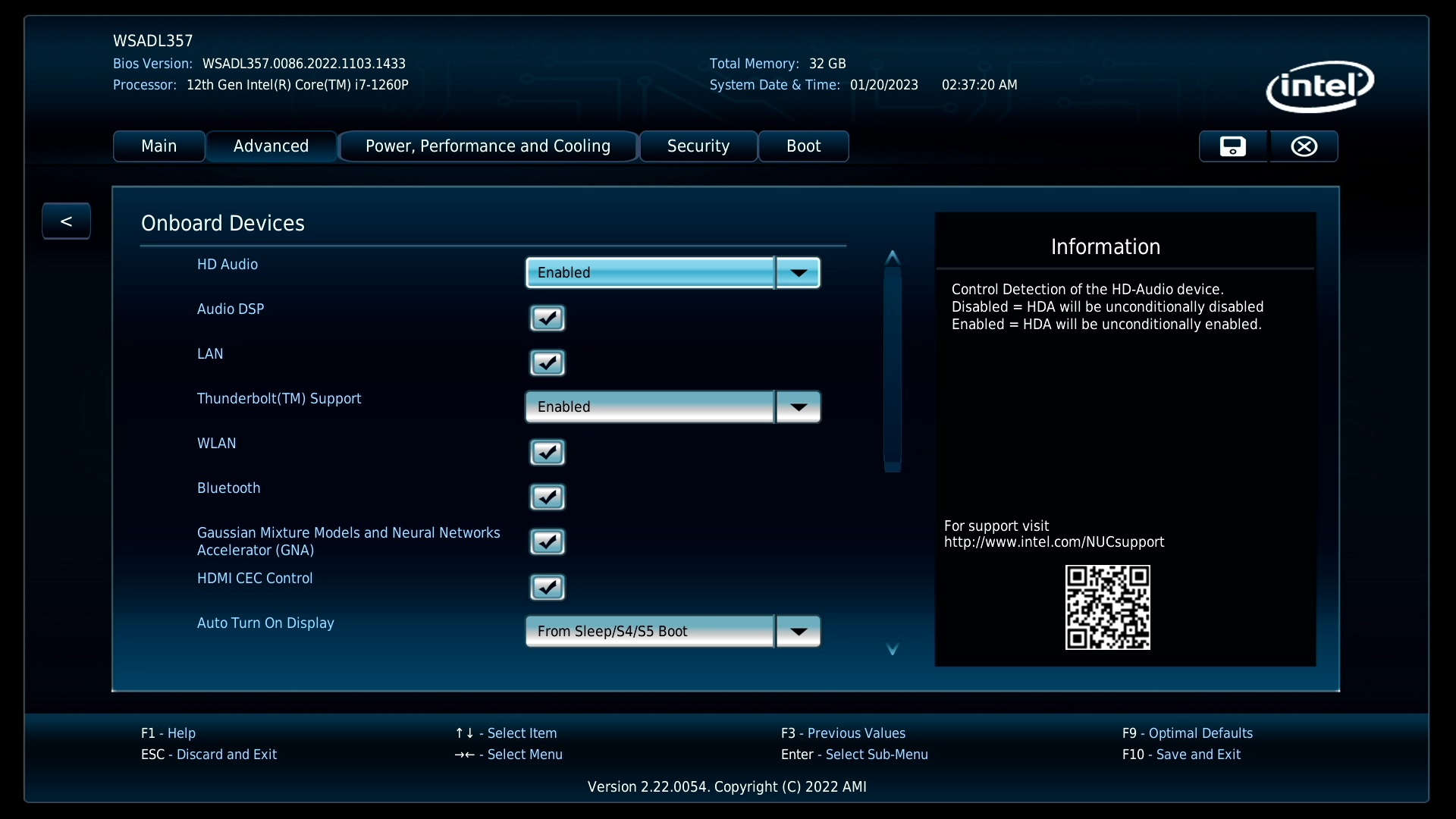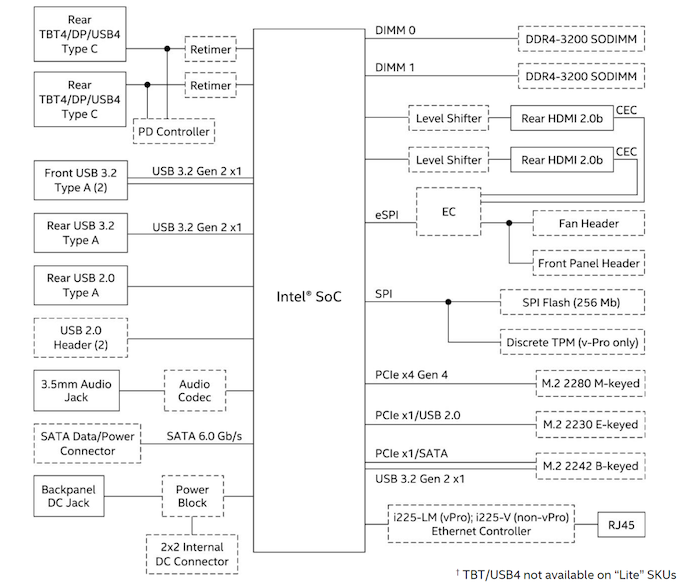Intel NUC 12 Pro Wall Street Canyon Kits Review: Alder Lake in UCFF Avatar
by Ganesh T S on January 26, 2023 11:30 AM ESTSetup Notes and Platform Analysis
Our review sample of the NUC12WSKi7 came with all necessary components pre-installed - we only had to load up the OS to start our evaluation process. Prior to that, we took some time to look into the BIOS interface. The video below presents the entire gamut of available options for the Wall Street Canyon NUC12WSKi7.
Intel's mini-PCs have the most comprehensive and configurable UEFI / BIOS among all the ones that we have evaluated over the last several years. The NUC12WSKi7 is no exception. The home screen shows the BIOS version, processor details, and installed memory capacity and speed right away - this is of great help in checking whether the installed SODIMMs are operating at the desired speeds. Under the 'Advanced' section, we have options to enable various SATA and M.2 NVMe ports, and disable the disk activity LED if needed. Different USB ports and headers can be selectively enabled or disabled. Display emulation for headless operation as well as digital signage purposes is also available.
The NUC12WSKv7's BIOS options are brought out in the above video. It must be noted that the processor used in the system (Core i7-1270P) is vPro-enabled, and the Intel Management Engine BIOS Extensions can be used to set up AMT for remote management. One of the pre-requisites for using the MEBx is password protection of both the BIOS as well as the MEBx itself. The MEBx options utilize the same interface as the other BIOS options.
The above screen capture of the BIOS options for the Bleu Jour Meta 12 includes a drill-down into the modification of the default PL1 and PL2 values and other associated parameters. Except for the reference to the Thunderbolt ports, the options are identical to the ones of the NUC12WSKi7.
| NUC12WSKi7 vs. NUC12WSBi70Z BIOS | |||

The block diagram below presents the overall high-speed I/O distribution in the Wall Street Canyon NUCs.
The mainstream NUCs are quite straightforward, as the PCH is integrated into the package and there is not much flexibility on the board design side to get creative with the allocation of the HSIO lanes.
In this review, we compare the three Wall Street Canyon NUC kits with a host of other UCFF systems.
| Comparative PC Configurations | ||
| Aspect | Intel NUC12WSKi7 (Wall Street Canyon) | |
| CPU | Intel Core i7-1260P Alder Lake 4P + 8e / 16T, up to 4.7 GHz (P) / 3.4 GHz (e) Intel 7, 18MB L2, 28W (PL1 = 40W, PL2 = 64W) |
Intel Core i7-1260P Alder Lake 4P + 8e / 16T, up to 4.7 GHz (P) / 3.4 GHz (e) Intel 7, 18MB L2, 28W (PL1 = 40W, PL2 = 64W) |
| GPU | Intel Iris Xe Graphics (96EU @ 1.40 GHz) |
Intel Iris Xe Graphics (96EU @ 1.40 GHz) |
| RAM | Crucial CT16G4SFRA32A.C16FR DDR4-3200 SODIMM 22-22-22-52 @ 3200 MHz 2x16 GB |
Crucial CT16G4SFRA32A.C16FR DDR4-3200 SODIMM 22-22-22-52 @ 3200 MHz 2x16 GB |
| Storage | Kingston KC2500 SKC2500M8500G (500 GB; M.2 2280 PCIe 3.0 x4 NVMe;) (Kioxia BiCS4 96L 3D TLC; Silicon Motion SMI 2262EN Controller) |
Kingston KC2500 SKC2500M8500G (500 GB; M.2 2280 PCIe 3.0 x4 NVMe;) (Kioxia BiCS4 96L 3D TLC; Silicon Motion SMI 2262EN Controller) |
| Wi-Fi | 1x 2.5 GbE RJ-45 (Intel I225-V) Intel Wi-Fi 6 AX211 (2x2 802.11ax - 2.4 Gbps) |
1x 2.5 GbE RJ-45 (Intel I225-V) Intel Wi-Fi 6 AX211 (2x2 802.11ax - 2.4 Gbps) |
| Price (in USD, when built) | (Street Pricing on January 25th, 2023) US $660 (barebones) $843 (as configured, no OS) |
(Street Pricing on January 25th, 2023) US $660 (barebones) $843 (as configured, no OS) |
Benchmarks were processed afresh on all of the above systems with the latest BIOS for each. The next few sections will deal with comparative benchmarks for the above systems.











25 Comments
View All Comments
abufrejoval - Sunday, January 29, 2023 - link
In the PC market, even "small" niches seem to be big enough to merit a product, otherwise Intel wouldn't keep on doing them.My main NUC use case is µ-servers in a 10Gbit cluster using cheap cascaded KVMs in the rare case I need the console. Near silent and low average power 24x7 operation is the goal, with enough peak power to get things done in a hurry.
Yes, you could build that from laptops, but unfortunately the ones that offer 64GB RAM and 2-8TB of NVMe as well as a TB port for 10GBit Ethernet are designed for gamers and carry quite a hefty premium and extras I don't need.
In corporate workplaces laptops have pretty much replaced small form factor PCs, even more so with the pandemic. But there are still quite a lot of profesisonal installations in public services, medical care and production, where NUCs mounted to a firmly attached display are quite the ticket.
Personally, I'd prefer to have Mini-ITX board variants for every NUC Intel builds, but that really seems too niche these days.
ottonis - Friday, March 17, 2023 - link
A NUC can be a tremedously useful device to power up a basic digital audio workstation (DAW), alongside external audio and midi devices. It has enough processing power to run even the most modern DAW (e.g. studio one) alongside a bunch of virtual instruments and effects. Once everything is installed and up and running, it may be useful to deactivate Wifi, Bluetooth and LAN and to purge the autostart menu from all but the most essential scripts and programs, in order to reduce DPC latency.It is so compact that it a dream come true for musicians wanting to save precious space in the homerecording studios or who are on the run and on tour and need to travel as light as possible.
So, if you know how to set this device up, it is an invaluable tool for musicians.
It's benefit over laptops: it has more I/O. I struggled to connect all my external devices with an otherwise great laptop, but the NUC can handle them all (4x USB-A + 2x USB-C)
CyrIng - Saturday, January 28, 2023 - link
The blue carton box has a better look than the NUC case.About Hybrid processors, CoreFreq is now monitoring Pcore and Ecore, including their own Turbo tunable tweaks
ISO available at www.cyring.fr
abufrejoval - Sunday, January 29, 2023 - link
The GPU-Z data is obviously bollocks: I was first thrown off by the low memory bandwidth of 25GB/s, which is really what DDR3 based GT3 solutions or single channel DDR4 might do (64-bit width may be another hint, because it's 128-bit on dual channel).I am seeing more like 40GB/s on my various Xe's, 38.4GB/s on an i7-1165G7 and 42GB/s on an i5-12500H with an 80EU Xe, both using DDR4-3200 SO-DIMMs.
But it's the pixel and texture fill rates and the GPU boost clocks where things must have been read wrong, nothing clocks 11GHz on CMOS just yet and the fill rates are matching the RTX2060 on my NUC11PHBi7 using GDDR6, 10GPixels and 21 GTexels are more realistic with 1.3GHz boost.
So please recheck the setup and data.
abufrejoval - Sunday, January 29, 2023 - link
It's too bad how Intel often just manages to get withini >90% of what I want, only to bungle it on the final stretch...The "blue day meta" variants (what on Earth did they smoke?) are rather intriguing because they seem to allow screwing say a Noctua fan on top (is there a matching fan connector on the board?): that could fix the major isse with the NUCs, too little volume/mass for cooling 20-30 Watts at acceptable noise levels.
What's critically missing for me, is the Thunderbolt ports, which I need for 10GBit networking, be it via Ethernet or TCP over TB. I believe those parts may still be in short supply, but I'd always pay €20-30 extra to have those ports.